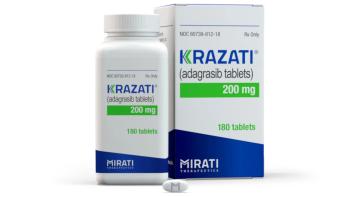
Providers
Latest News
Latest Videos
CME Content
More News

Investigators highlighted Raman spectroscopy, a noninvasive diagnostic technology that could lead to faster, earlier detection of skin cancer.

Joseph Saseen, PharmD, discussed the importance of knowing lipoprotein a (Lp[a]) levels to enable clinicians to provide the best patient care and spread awareness to those who might be affected.

This article appears in the April issue of Evidence-Based Oncology.

Patients with chronic lymphocytic leukemia (CLL) who experience Richter transformation have a poor prognosis, but ibrutinib may help boost the efficacy of chimeric antigen receptor T-cell therapies.

Researchers warned that to achieve such reductions, greater uptake of the medication among indicated patients is needed.

A higher percentage of accountable care organization (ACO) primary care providers was associated with physician leadership, upside financial risk, and financial compensation of physicians tied to performance measures.

A coverage with evidence development (CED) study demonstrated significant and clinically meaningful benefits in patients with migraine treated with remote electrical neuromodulation (REN). Health plans should support clinicians’ REN prescriptions by ensuring adequate coverage.

Experts highlight groundbreaking research presented at the American College of Cardiology Annual Scientific Session (ACC.25), which emphasized a shift toward more personalized, evidence-based treatment strategies.

Findings from the SUMMIT, Altshock-2, and FAIR-HF2 trials were presented at the American College of Cardiology 2025 Annual Scientific Session.

Caspian Oliai, MD, MS, medical director of the UCLA Bone Marrow Transplantation Stem Cell Processing Center, discusses findings from the phase 3 Precision-T trial of Orca-T in acute leukemia and myelodysplastic syndrome (MDS).

Mobile self-management programs like that offered by Hello Heart can benefit employers and patients alike as they seek to manage and prevent heart disease.

Prior authorizations create substantial administrative and financial burdens on physicians and patients and can disrupt the continuity of care.

Strategies to enhance virtual care through quality assurance frameworks, technological innovation, and provider support were laid out in a pair of posters presented at the recent AMGA Annual Conference.

Anna Mueller, MD, Mount Sinai, presented the findings at the American College of Cardiology 2025 Annual Scientific Session and explained that broader adoption of imaging assessments will depend on further research.

At the American College of Cardiology 2025 Annual Scientific Session, John W. Ostrominski, MD, of Brigham and Women’s Hospital, dives into the nuanced safety profile of finerenone for high-risk patients with heart failure.

STRIDE investigator Marc Bonaca, MD, MPH, University of Colorado School of Medicine, highlights how the data could provide insight into peripheral artery disease and type 2 diabetes treatment options.

Christian T. Ruff, MD, MPH, of Brigham and Women's Hospital, discusses new data comparing abelacimab with rivaroxaban in patients with atrial fibrillation presented at the American College of Cardiology 2025 Annual Scientific Session.

Implementing artificial intelligence (AI) has transformed clinicians' and health systems' ability to screen for and distinguish forms of cardiorenalmetabolic disease.

Erythropoiesis-stimulating agent (ESA) treatment before or early after regular transfusion therapy improved overall survival (OS) In lower-risk myelodysplastic syndromes (MDS), a new study found.

While the overall effectiveness of collaborative care has been well established, this study aimed to determine which specific components had the most impact.

Phase 2 results reported at the European Lung Cancer Conference show a favorable signal for overall survival for the first-line treatment of KRAS-mutated non–small cell lung cancer (NSCLC). A phase 3 trial is enrolling now.

Medication nonadherence to oral anticoagulants and oral anti–prostate cancer medication has been scrutinized through new research conducted among patients and health care providers and presented by the American Medical Group Association at its 2025 annual meeting, held March 26-29 in Grapevine, Texas.

WVE-N531 demonstrated statistically significant improvements in muscle biopsy measures and functional measures in patients with Duchenne muscular dystrophy (DMD) in the phase 2 FORWARD-53 trial.

For higher-risk multiple myeloma (MM), successful patient selection and monitoring strategies are vital for the management of adverse events and the disease itself.

Charles C. Wykoff, MD, PhD, Retinal Consultants of Texas, spoke to the current state of research on revakinagene taroretcel in macular telangiectasia type 2 (MacTel), as well as the importance of patient groups for the rare condition.





















































